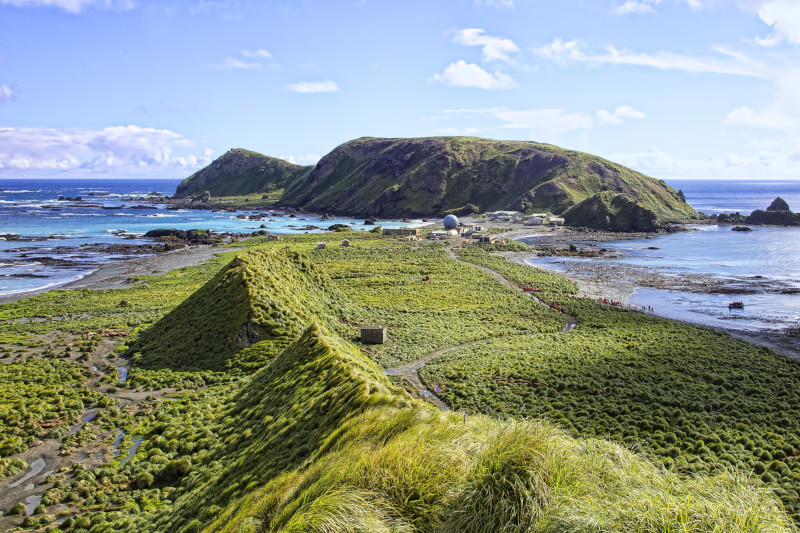
Macquarie Island Facts
- This stunning isolated location bears the name of Macquarie Island. Though remote, it plays a vital role in the ecology of the region. That importance ranks as so great that it’s been named a UNESCO World Heritage Site. The location’s also a highly important research site.
- Despite that importance, however, the island remains almost entirely devoid of human life. The human presence on the island varies between 20 -40 individuals at any one time. That’s because only researchers temporarily based at the facilities there live on the island.
- The original base opened in 1911, under Douglas Mawson. Since then, it’s been under the jurisdiction of the Australian National Antarctic Research Expedition. The research facility draws its name from Lachlan Macquarie, a local figure in the early 19th century.
- The first known sighting of this marvel of geology occurred in the year 1810. At that time, an Australian sealer named Frederick Hasselborough spotted it. Evidence, however, indicates that ancient mariners knew of it, since he also spotted the remains of an ancient wreck.
- The original facility now bears the appropriate name of the Macquarie Island Station. There, the scientists conduct research in several important areas. These include, biology, meteorology, and human environmental impact, and perhaps most importantly, geosciences.
- In the intricate field of geoscience, stunning Macquarie Island offers an unparalleled opportunity to scientists. That’s due to a surprising statistic. This amazing site actually forms the only known spot where rocks from the earth’s mantle are actively exposed above sea-level.
Related Articles
Macquarie Island Physical Description
Though the wonder of Nature and geology known to man as Macquarie Island almost immediately captures the attention of anyone visiting it, the site does not do so due to its physical dimensions. That’s true given the simple fact that Nature packed its many marvels into a smaller package.
The attention-grabbing site measures approximately 21 mi (34 km) in length and 2 mi (3.2 km) in width. Overall, that gives the island a total area equaling roughly 47 sq mi (123 sq km). Further distinguishing it, the remote formation additionally possesses a highly elongated general shape.
The majority of the amazing island has a generally flattened structure to it. The overall elevation of the marvelous spot merely measures roughly 800 ft (240 m). This altitude does, of course, vary in some random places. Distinctively, this holds true right up to the shoreline in most places.
This ancient marvel of geology isn’t entirely flat, however. That’s because the beautiful site does hold a certain number of moderately elevated locations. Some individual hills, highly rounded in nature, do appear. These rise to heights of as much as 1,200 – 1,400 ft (365 – 425 m).
At the shoreline, however, this situation changes extremely rapidly. That’s because the coast of Macquarie Island drops off precipitously in throughout most regions. But its many wonders don’t simply stop there. Impressively, even a few small glacial lakes dot the island in various locations.
Macquarie Island Location, Formation, and Ecosystem
The remarkable Macquarie Island formed in an undeniably remote corner of the globe. More precisely, it lies within the confines of a sub-antarctic region of the Southern Ocean. Its exact coordinates place the island almost precisely between the continents of Australia and Antarctica.
The landmass boasts an utterly unique geological situation, due to its nature. It actually represents only a tiny part of a much larger structure. That’s the similarly-named Macquarie Ridge. That’s an undersea formation, pushed into its location through the actions of tectonic plates.
The island itself represents only the exposed crest of this much larger structure. The base of the astounding formation actually lies far below the waves. This lies at a depth of roughly 3.7 mi (6 km) beneath the surface of the ocean. This mainly, though not just solely, consists of basalt.
The majesty and importance of Macquarie Island dos not simply stop there, though. It’s also a highly important site for both flora and fauna. A total of at least 25 different known species of birds use it for breeding purposes. For some of those, in fact, it’s the only site they use for that.
Among the most notable avians breeding in this spot are albatrosses and petrels. The most noted, though, consists of the awesome royal penguin. This location currently represents the only known breeding site for that species in the entire world. It also holds a small colony of fur seals.
Its selection of native flora, though, remains somewhat smaller in size. For one, no native tree species appear on the site. It does boast other types of vegetation, though. These mainly include various grasses and mosses. The most remarkable exception to that is a native orchid.
Features Sharing Its Region
Check out our other articles on 7 Intriguing South Carolina Insects, Vietnamese Mossy Frog, Carbet Falls, Holy Ghost Orchid, South American Sea Lion, Nicobar Pigeon, Mount Olympos
